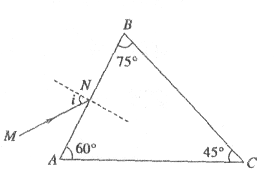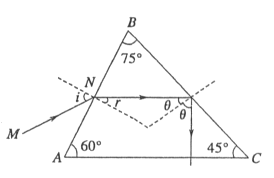问题
计算题
(10分)如图所示是一种折射率 的棱镜。现有一束光线沿MN方向射到棱镜的AB面上,入射角的大小i=60°,求:
的棱镜。现有一束光线沿MN方向射到棱镜的AB面上,入射角的大小i=60°,求:

(1)光在棱镜中传播的速率;
(2)画出此束光线进入棱镜后又射出棱镜的光路图,要求写出简要的分析过程。
答案
(1)  (2)
(2)

(1)光在棱镜中传播的速率 (2分)
(2分)
 (2分)
(2分)
(2)由折射率 得:AB面上的折射角
得:AB面上的折射角 。
。
由几何关系得:BC面上的入射角
全反射临界角
则光在BC面上发生全反射,光线垂直AC射出。(2分)
光路如图所示(4分)

本题考查光的折射定律,和公式v=c/n的应用,由光路图和全反射条件可判断光线在BC面发生全反射
